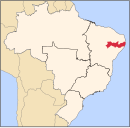Lagoa do Ouro
 Brazil
Brazil Pernambuco
PernambucoLagoa do Ouro (Golden Pond) is a city located in the state of Pernambuco, Brazil, located 263 km (163 mi) west from Recife.
History
In early 1902, Captain Amador José Monteiro of the Brazilian National Guard presented a manifesto to the Municipal Council of the municipality Correntes. The council gathered on February 9, 1902, and authorized the first fair of the village. The council also approved of the town's name of Igatauá during this meeting. On December 9, 1938, the name was changed to Lagoa do Ouro due to an urban legend that arose in the village, where nuggets or gold bars were believed to be in a local pond belonging to the estate of João Alves da Silva, who became known as John Gold.[3]
Geography
The municipality contains part of the Pedra Talhada Biological Reserve, a fully protected conservation unit created in 1989.[4]
Climate
Lagoa do Ouro has a tropical savanna climate (Aw) according to the Köppen climate classification.
Economy
The main economic activities in Lagoa do Ouro are based in agribusiness. Beans, manioc, corn and livestock such as cattle, sheep and poultry are the main agricultural resources within the municipality.
Economic indicators
| GDP x (1000 R$)[5] | GDP pc (R$) | PE |
|---|---|---|
| 39.597 | 3.397 | 0.06% |
Economy by Sector (2006)
| Primary sector | Secondary sector | Service sector |
|---|---|---|
| 20.05% | 8.11% | 71.84% |
Health indicators[6]
| HDI (2000) | Hospitals (2007) | Hospitals beds (2007) | Child mortality rate per 1,000 births (2005) |
|---|---|---|---|
| 0.569 | 1 | 17 | 27.7 |
References
- ^ "Brazilian Territorial Area. Brazilian Institute of Geography and Statistics (IBGE) (1 July 2013)". Ibge.gov.br. Archived from the original on 2011-11-01. Retrieved June 23, 2016.
- ^ IBGE 2020
- ^ "Lagoa do Ouro História". Cidades.ibge.gov.br (in Portuguese). Retrieved October 24, 2018.
- ^ Helaeson de Almeida (November 2006), Plano Operativo de Prevenção e Combate aos Incêndios Florestais da Reserva Biológica de Pedra Talhada (PDF) (in Portuguese), archived from the original (PDF) on 2012-08-24, retrieved April 16, 2016
- ^ Lagoa do Ouro 2007 GDP IBGE page 30 Archived March 4, 2016, at the Wayback Machine
- ^ "PE State site - City by city profile". Archived from the original on 2009-08-04. Retrieved 2009-08-20.
- v
- t
- e
Agreste Pernambucano
| Alto Capibaribe | |
|---|---|
| Brejo Pernambucano | |
| Garanhuns | |
| Médio Capibaribe | |
| Vale do Ipanema | |
| Vale do Ipojuca |

Mata Pernambucana
| Mata Meridional Pernambucana | |
|---|---|
| Mata Setentrional Pernambucana | |
| Vitoria de Santo Antão |
Metropolitana de Recife
| Itamaracá | |
|---|---|
| Recife | |
| Porto de Suape | |
| Fernando de Noronha |
Sao Francisco Pernambucano
| Itaparica | |
|---|---|
| Petrolina |
Sertão Pernambucano
| Araripina | |
|---|---|
| Pajeú | |
| Salgueiro | |
| Sertão do Moxotó |
 | This Pernambuco, Brazil location article is a stub. You can help Wikipedia by expanding it. |
- v
- t
- e













